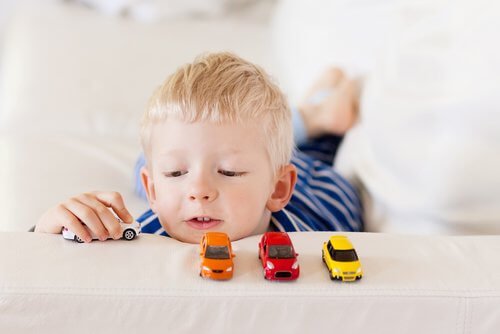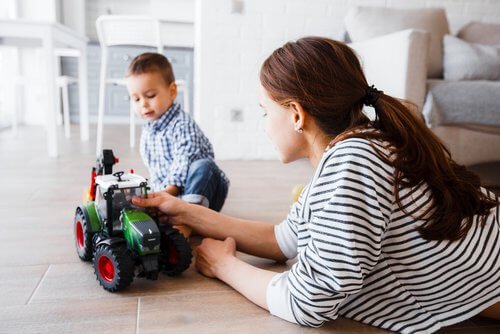Toddler Toy Car - 3 Ways to support early language
Toy cars are simple, fun, and perfect for practicing speech and language skills at home with your little one.
In this post we are going to show you how you can use the toy cars you already have at home to support your child at different stages of communication development. We’ll talk about how you can practice at home whether your child:
I’ll also share my best toddler car toys list with you. Rest assured, you can use any of your toddlers small car toys they can push with one hand for these activities, but sometimes it’s nice to play with a new toy together!
Toy Cars
Toddlers develop speech, language, and play skills in parallel (take a deeper dive into the connection between play & language here).
I’ve created 3 different toddler stages (listed below) so you can easily find the best way to play with peg puzzles to grow speech and language skills at home based on where your child is starting.
Explorers - see the Explorer’s activity
An Explorer has not said their first word yet, but they are exploring communication! They let you know their wants and needs by crying, gesturing, and making sounds.
Pioneers - see the Pioneer’s activity
Pioneers say a few, or even as many as 100 words. They are still learning pronunciation skills and they often talk in their own language.
Builders - see the Builder’s activity
Builders talk in short sentences. They enjoy having little conversations and ask questions.
Explorers: Toddlers working to say their first few words
How to Play:
The goal of playing cars with your explorer is to have fun and encourage them to copy what you are doing (rather than what you are saying just yet!). Explorers are developing the skill of imitation, which is usually learned first in play. Encouraging them to copy your actions is a building block towards copying what you say later on.
When you play cars with your Explorer, you will practice pushing and chasing cars. Push the car on the floor and watch it go. It may crash into a wall or furniture. Repeat this many times and encourage your child to try to copy you by pushing their own car and rolling it around your house.
If you’re able, you can chase the car when it goes by crawling on the floor. You can make it look really fun and encourage your child to chase the cars with you.
Then try changing it up by pushing the cars different distances or playing in different rooms in your house. You might also push your car off the edge of the couch or give your car a wash in the sink.
What to Say:
When you push the car, make a car sound effect (like “Vroom!”) When the car crashes, make a crashing sound (like “Crash!” “Boom!” or “Oh-No!”). You may also use playful words like “Woah!” and “Yay!” while playing with the cars. Although your child may not be copying your sounds just yet, you are showing them some of the words they might say first when they are playing cars when they are ready.
Pioneers: Toddlers who say between 5-100 words
How to Play:
When you play cars with your Pioneer, you will set up a ramp to push cars down. You can create a simple ramp with a couch cushion, book or wrapping paper tube. Have the car go up the ramp slowly and then push it down quickly. This game is super fun and super simple, which is perfect for teaching new words.
What to Say:
As you move the car up the ramp, say “up up up up”. Then as you push the car down the ramp, say “doooooowwwwn!” If the car crashes, you can also say “crash” or make a crashing sound effect (like “crash!” “boom!” or “oh no!”).
Once your child has learned these words you can begin introducing new words, like slow and fast. Push the car up the ramp very slowly and then let it roll down the ramp going “Fast fast fast!!!”
Builders
How to Play:
A car race is a super fun activity to practice speech and language at home if your child is at the builder stage. A good old fashioned race is the perfect way to practice putting words together and answering simple questions.
You can set up your car race any way you like. It’s okay to follow your toddler’s lead on the set up of your race as you’ll be able to practice speech and language any way you play together.
The easiest way to do this is to have two or a few cars for you and your little one to race. You’ll create an imaginary starting line and all the race cars line up behind it. Your toddler will probably love starting the race by saying “Ready Set Go!!” Race the cars against one another to see who crosses your finish line first.
What to Say:
Think about having a conversation with your child as the cars race. You can use more descriptive words to practice putting words together, like “the car with red flames,” “the blue tow truck,” and “the car with big wheels.” You can ask questions like “Which car do you want?” and “Who won the race?”
Continue to expand upon the words your child already knows. You might comment on locations, such as “The blue car got stuck on the carpet” or “The red truck didn’t fit under the bridge.”
This is a great opportunity to also let your child ask you questions and make observations of their own about the race. Take turns modeling new language for your child and listening to hear what they have to say, it’s all about the back and forth here!
Best Toddler Car Toys
Here are my favorite toddler toy cars that I use in speech therapy all the time!
As I said before, you can use pretty much any toy car or truck you already have at home. But, if you’re looking for a new and awesome toy to add to your collection, consider one of these options!
*Always follow manufacturer’s recommendation for age*
This post contains affiliate links. As an Amazon Associate, Toddler Talk earns from qualifying purchases. Proceeds help support these resources.I use this toy ALL the time in speech therapy! I love that it can be a simple car to push around, shape sorter, or fun for pretend play with the characters.
A bigger car (or truck) is perfect for young toddlers. It’s often easier for them to push the big cars. Plus, they love to fill and empty the dump truck!
If you’re looking for a toy that grows with your toddler this one is perfect! Use the cars by themselves, push them down the ramp, or go & down in the elevator.
A few more notes about practicing speech at home with toy cars:
-
Any toy can be used to help grow speech & language. The best toys are always the toys your child enjoys playing with! When they are happy and excited, they are most likely to learn.
-
As we’ve learned, toy cars can be used to help build toddler language. Toy cars can also help with hand-eye coordination and dexterity (although these aren’t my areas of expertise - refer to an occupational therapist for these skills).
-
Toddlers learn through play, so toys can have a big impact on their language development. Read more about how play and language develop in parallel here.
Written By: Stephanie Hatleli MS CCC-SLP & Stephanie Burgener-Vader MA CCC-SLP
© 2020-2025. Stephanie Keffer Hatleli, MS CCC-SLP. All Rights Reserved.
The content offered on ToddlerTalk.com is for informational purposes only. Toddler Talk is not engaged in rendering professional advice, whether medical or otherwise, to individual users or their children or families. No content on this site, regardless of date, should ever be used as a substitute for direct medical advice from your doctor, speech language pathologist, or other health professional. By accessing the content on ToddlerTalk.com, you acknowledge and agree that you are accepting the responsibility for your child’s health and well-being. In return for providing you with information related to home speech and language practice, you waive any claims that you or your child may have as a result of utilizing the content on ToddlerTalk.com.









